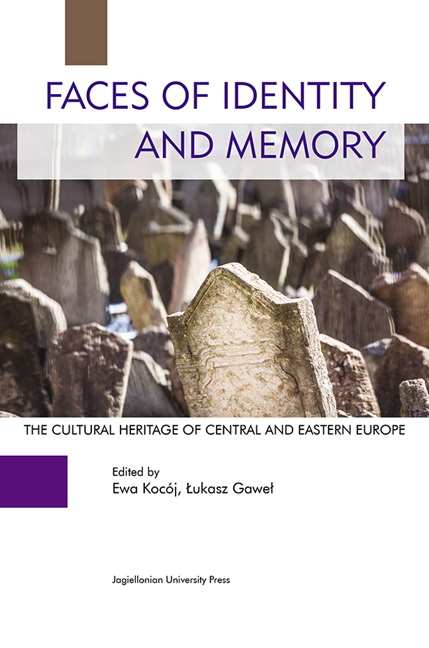 Faces of Identity and Memory
Faces of Identity and Memory Book contents
- Frontmatter
- Contents
- Introduction
- Memory and Identity. Monuments of Romanian Tangible Culture Inscribed on the UNESCO World Heritage List (a Short Presentation)
- Inventorisation and Recording of Sacral Art Objects in Lithuania in 1995–2005
- National lieux de mémoire and the European Heritage Label. Some Reflections on the Case of the Gdańsk Shipyard
- Porrajmos. Constructing Gypsy Holocaust Memory in the Recent Cinema
- The Vacuum and the Imagination of Space. The Cultural Role of the Żyznowski Publishing House
- Cultural Animation as the Art of Remembering. The Activities of the “Borderland of Arts, Cultures and Nations” Centre in Sejny
- ‘The Painted Village’ – Zalipie as an Expression of Ethnographic Tourism in the Powiśle Dąbrowskie Region of Poland
- 20th Century Theatrical Heritage: The Escape from Illusion
- Protection of Cultural Heritage. The Case of Krakow
- Managing an Artist's Legacy on the Example of Foundation for Support of Modjeska's Life and Art Research in Kraków
- Culinary Heritage as Used in the Present. Selected Elements of the Culinary Heritage Management in Contemporary Poland
The Vacuum and the Imagination of Space. The Cultural Role of the Żyznowski Publishing House
Published online by Cambridge University Press: 10 January 2018
- Frontmatter
- Contents
- Introduction
- Memory and Identity. Monuments of Romanian Tangible Culture Inscribed on the UNESCO World Heritage List (a Short Presentation)
- Inventorisation and Recording of Sacral Art Objects in Lithuania in 1995–2005
- National lieux de mémoire and the European Heritage Label. Some Reflections on the Case of the Gdańsk Shipyard
- Porrajmos. Constructing Gypsy Holocaust Memory in the Recent Cinema
- The Vacuum and the Imagination of Space. The Cultural Role of the Żyznowski Publishing House
- Cultural Animation as the Art of Remembering. The Activities of the “Borderland of Arts, Cultures and Nations” Centre in Sejny
- ‘The Painted Village’ – Zalipie as an Expression of Ethnographic Tourism in the Powiśle Dąbrowskie Region of Poland
- 20th Century Theatrical Heritage: The Escape from Illusion
- Protection of Cultural Heritage. The Case of Krakow
- Managing an Artist's Legacy on the Example of Foundation for Support of Modjeska's Life and Art Research in Kraków
- Culinary Heritage as Used in the Present. Selected Elements of the Culinary Heritage Management in Contemporary Poland
Summary
In the autumn field the scarecrow looks like a visitor.
In the winter field the scarecrow looks like a beggar.
But not at all.
When you count the villagers, one, two…
you have to count the scarecrow too.
ScarecrowAbstract: Vacuum poses a challenge to imagination. Imagination seems expendable when everything is obvious and out in the open. More oft en than not, the imagined tends to be more terrifying than the real. The fear of an imaginary monster, the fear of fear itself – these are familiar inhabitants of not just a child's imagination. However, it is a diff erentkind of fear and a different kind of imagination that this chapter is going to be about; it will also tackle an entirely diff erentkind of vacuum. My understanding of the ancient horror vacui – nature abhors a concept of vacuum – refers to such a state of mind which compels one to fill that empty space with entities – as a way of preserving them from obliteration. It is, ultimately, about the role of memory and its key actor, imagination – for is not the latter indispensable for the existence of the former?
The goal of this chapter was to examine the phenomenon of such imagination, which, born out of the commitment of a handful of passionate individuals, may attain a powerful moral dimension – so powerful in fact, that it is capable of permanently affecting the social environment of the town in which it happens and as a result change its populace's perception of their familiar urban space forever. My main research interest has lain in studying the emotional and intellectual mechanisms of the process, in establishing what motivates some people to become dedicated to the idea of reinstating the memory of once vibrant, but today nonexistent local minority communities. To that purpose I relied on qualitative methodology (interviews, participant observation, and text analysis) which has enabled me to construct the ethnography of my subject of study, the Żyznowski Publishing House.
Key words: imagination in management, the experience of space and place, horror vacui, Jewish studies
Introduction
Vacuum poses a challenge to imagination. Imagination seems expendable when everything is obvious and out in the open. Since childhood, we have been extracting shapes out of the darkness, illuminating them with our imagination.
- Type
- Chapter
- Information
- Faces of Identity and MemoryThe Cultural Heritage of Central and Eastern Europe (Managing and Case Studies), pp. 89 - 112Publisher: Jagiellonian University PressPrint publication year: 2015


